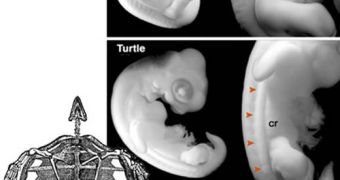Turtles are very peculiar animals altogether, researchers have learned over the years. In addition to their queer and unique body structure, they are also very difficult to analyze in terms of origins, and scientists have debated which is the closest relative to the shelled creature for a long time. While some say that they come from reptiles, others maintain they are related to snakes, while some place them in the same category as birds. That's the reason why a new study was conducted on turtle embryos, in an attempt to discover the relations that exist between this and other species.
The thing that puzzles researchers the most is that the turtles appear as fully formed creatures in the fossil records, meaning that no intermediary step or missing link between them and any other species has ever been positively identified. In such circumstances, the field of comparative embryology may be the only one able to shed some light on the animals' evolution. Japanese researchers at the RIKEN Center for Developmental Biology, in Kobe, therefore compared the embryos of turtles with those of chickens and mice, in an attempt to find the factors that differentiated the two, ScienceNow informs.
The research “is a really wonderful example of classical comparative embryology. It's very consistent with the work that's come before looking at turtle evolution, but it adds this extra level of detail in terms of the musculature of the shoulder girdle, which is where all the action is,” Wesleyan University Evolutionary Morphologist Ann Burke, from Middletown, Connecticut, explains. The expert held her dissertation on turtle development. A new paper detailing the finds appears in the July 9th issue of the journal Science, and is authored by Evolutionary Developmental Biologist Shigeru Kuratani.
The main difference between turtles and other four-legged critters is the disposition of the shoulders in regards to the rib cage, anthropologists point out. While in most species, including humans, the shoulders are located on the exterior of the ribs, in turtles they are located on the inside. This shift in bone structure allows them to grow their renowned shell, which is entirely made up of bone tissue, welded together in an impenetrable shield.
The embryo study theoretically revealed that there should have been some type of intermediary step in turtle evolution at some point, when the shoulder blades were outside the rib cage. And, indeed, the oldest turtle fossil shows a bone layout in which the shoulders were not inside the rib cage, but in an arrangement that hinted at the fact that previous generations had their shoulder bones outside of the rib cage.

 14 DAY TRIAL //
14 DAY TRIAL //